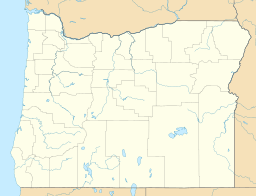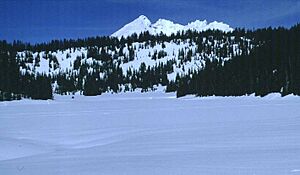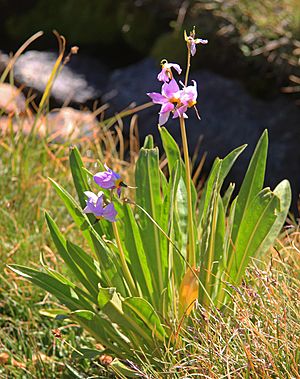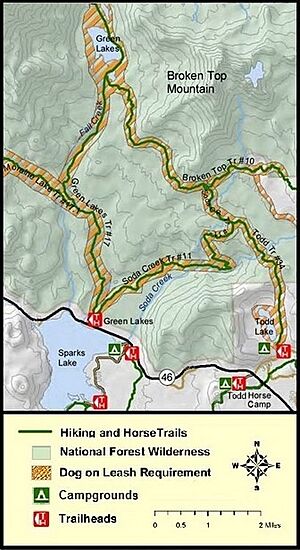Todd Lake (Oregon) facts for kids
Quick facts for kids Todd Lake |
|
|---|---|

Todd Lake with Mount Bachelor beyond
|
|
| Location | Deschutes National Forest, Oregon |
| Coordinates | 44°01′47″N 121°41′07″W / 44.0298°N 121.6853°W |
| Type | Natural |
| Primary inflows | Snow melt and Bare Lake drainage |
| Primary outflows | Todd Creek |
| Catchment area | 0.9 square miles (2.3 km2) |
| Max. length | 0.5 mi (0.80 km) |
| Max. width | 0.15 mi (0.24 km) |
| Surface area | 45 acres (0.18 km2) |
| Average depth | 21 ft (6.4 m) |
| Max. depth | 60 ft (18 m) |
| Shore length1 | 1.2 mi (1.9 km) |
| Surface elevation | 6,150 ft (1,870 m) |
| 1 Shore length is not a well-defined measure. | |
Todd Lake is a beautiful natural lake in central Oregon, United States. It's found high up in the Cascade Range mountains. The lake is about 45 acres (18 hectares) big. It was named after John Y. Todd, who was an early settler in the area.
Today, the United States Forest Service looks after Todd Lake and the surrounding forest. This area is part of the Deschutes National Forest. The Oregon Department of Fish and Wildlife adds brook trout to the lake regularly. Todd Lake is a popular spot for outdoor fun. In summer, people enjoy picnicking, fishing, hiking, and watching nature. In winter, the trails are great for cross-country skiing and snowshoeing.
Contents
History of Todd Lake
Todd Lake was once called "Lost Lake." This was because it was very hard for people to find. In the early 1900s, people from Bend, Oregon, asked for the name to be changed. They wanted to avoid confusion with other lakes in Oregon called "Lost Lake."
How Todd Lake Got Its Name
In 1922, the lake's name was officially changed to Todd Lake. This name honors John Y. Todd. He was a pioneer who moved to Oregon in 1852. In 1860, he built the first bridge over the Deschutes River. Later, he became a successful cattle rancher. John Todd also started the Farewell Bend Ranch. This ranch gave the city of Bend its name.
Protecting the Area
Todd Lake and the nearby forest are part of the Bend-Fort Rock Ranger District. This is a section of the Deschutes National Forest. In 1964, the United States Congress created the Three Sisters Wilderness. This wilderness area is around the Three Sisters mountains. Todd Lake is just outside the southern edge of this wilderness. Because of this, it's a main starting point for hikers going into the wilderness.
The Scenic Highway
The main way to get to Todd Lake has always been Forest Road 46. This road is also known as the Cascade Lakes Highway. In 1989, the Forest Service called it a National Forest Scenic Byway. Then, in 1997, Oregon made it a state scenic byway. A year later, the U.S. government officially named it a National Scenic Byway. It's now called the Cascade Lakes Scenic Byway. Many travel guides mention Todd Lake as the first lake you see along this scenic route.
Geography and Lake Features
Todd Lake is on the east side of the Cascade Range in central Oregon. It is about 24 miles (39 km) southwest of Bend. The lake sits in a small valley created by a glacier. This glacier melted about 13,000 years ago. It left behind a bowl-shaped area called a glacial cirque. This is why the lake is quite deep for its size. The lake is 6,150 feet (1,875 meters) above sea level.
Water Sources
Most of the water in Todd Lake comes from melting snow. The only water that flows into the lake all year round is from Bare Lake. Bare Lake is a very small lake about 0.5 miles (0.8 km) southwest of Todd Lake. The only place water flows out of Todd Lake is Todd Creek. This creek starts at the south end of the lake. Todd Creek then disappears into a lava field about 2 miles (3 km) southwest of the lake.
Lake Size and Depth
Todd Lake is a natural lake that covers about 45 acres (18 hectares). It is about 0.5 miles (0.8 km) long. It is also about 0.15 miles (0.24 meters) wide. The lake is usually about 21 feet (6.4 meters) deep. But it can be as deep as 60 feet (18 meters) near its south end.
Environment and Water Quality
The area that drains into Todd Lake is small, covering only 0.9 square miles (2.3 km2). This area is covered by a thick conifer forest. Trees like mountain hemlock, lodgepole pine, and different fir species grow here. There are also meadows along the south and west sides of the lake. A larger meadow is at the north end.
Water Layers
Because Todd Lake is in a sheltered spot, its water has different temperature layers. Water deeper than 15 feet (4.6 meters) stays very cold, even in summer. The water's alkalinity is like other high-up lakes in the Cascade Range. The water is very clear. You can see down about 23 feet (7 meters) with a Secchi disk. There isn't much chlorophyll in the lake. A study in 1982 found a lot of phosphorus, which is common in mountain lakes. The lake's health is considered "oligotrophic," meaning it's very clean and has few nutrients.
Plant Life (Flora)
There are many different kinds of plants around Todd Lake. The forest has mountain hemlock, lodgepole pine, and various fir trees. In the shady parts of the forest, you can find plants like bog huckleberry and whortleberry. You might also see smooth woodrush, Brewer's mitrewort, and sidebells. In open forest areas, Jacob's ladder, alpine lake agoseris, and larkspur are common.
Wildflower Blooms
The meadows around Todd Lake are famous for their beautiful wildflowers. These flowers bloom from late June to mid-August. The best time to see them is in mid-July. Many wildflowers keep blooming all summer. This makes Todd Lake a perfect place to enjoy nature. The Forest Service even calls Todd Lake a special wildflower viewing area.
The wildflower show starts in late June. That's when Jeffrey's shooting star and white marsh marigold bloom. They grow in the wet meadows and along the streams. Newberry's knotweed blooms early on the dry slopes above the lake. Then, elephanthead and other mountain plants start to bloom. They appear in the meadows and along the lake shore.
Common Wildflowers
Many wildflowers grow in the meadows. These include Jeffrey's shooting star, elephanthead, Gorman's buttercup, alpine asters, American alpine speedwell, Indian paintbrush, small-flowered paintbrush, high mountain cinquefoil, Gray's ligusticum, green false hellebore, swamp laurel, and white bog orchid. Jeffrey's shooting star and marsh marigold grow close to the lake shore. In the wet area near the lake's outlet, you can find Gorman's buttercup, yellow monkeyflower, Lewis monkey flower, arrowleaf groundsel, and false asphodel. Oregon saxifrage lives in some of the boggy spots.
On the edge of the meadows, near the forest, you can see high mountain cinquefoil, Gray's ligusticum, Sitka valerian, cobwebby Indian paintbrush, harsh Indian paintbrush, broadleaf lupine, and alpine lake agoseris. On drier slopes above the lake, you'll find Newberry's knotweed, larkspur, bracted lousewort, peregrine fleabane, dwarf lupine, sulphur flower, Martindale's lomatium, pussypaws, pink mountain heather, and Brewers mountain heather.
Animal Life (Fauna)
The Oregon Department of Fish and Wildlife regularly adds brook trout to Todd Lake. These are the only game fish you'll find there. The trout are usually 8 to 10 inches (20 to 25 cm) long. Some can even grow to 15 inches (38 cm).
Reptiles and Amphibians
Many reptiles and amphibians live in and around Todd Lake. Reptiles include the common garter snake and northern alligator lizard. Amphibians include the western toad, Cascade frog, Oregon spotted frog, Pacific chorus frog, Pacific giant salamander, northwestern salamander, Oregon slender salamander, clouded salamander, Dunn's salamander, long-tailed salamander, and rough-skinned newt. The western toad and Cascade frog are special. They are protected species by the Oregon Department of Fish and Wildlife. It is against the law to harm or collect them.
Birds of Todd Lake
Over 160 types of birds live in the Todd Lake area. Birdwatchers can see many kinds of waterfowl, songbirds, forest birds, and birds of prey. Waterfowl include mallards, wood duck, American wigeon, northern shoveler, American coot, Barrow's goldeneye, common merganser, hooded mergansers, and Canada geese. Common shore and wetland birds include American dipper, spotted sandpiper, black tern, double-crested cormorant, great blue heron, and sandhill crane.
The meadows and forest are home to many songbirds. These include American goldfinch, Cassin's finch, pine siskin, red crossbill, Brewers sparrow, house sparrow, song sparrow, yellow-rumped warbler, and many types of flycatchers, chickadees, and thrushes. Other forest birds include northern flicker, Clark's nutcracker, red-breasted nuthatch, Brown creeper, pinyon jay, Steller's jay, and California quail. You can also find several woodpecker species and two types of hummingbirds.
Todd Lake also attracts many birds of prey. There are seven types of owls, including the northern pygmy owl and great horned owl. You might also see American kestrels, peregrine falcons, northern goshawks, Cooper's hawks, red-tailed hawks, osprey, golden eagles, bald eagles, and turkey vultures.
Mammals
The forest around Todd Lake is home to many mammals. Large mammals include black-tailed deer, Roosevelt elk, coyotes, American black bear, bobcats, and cougars. Smaller mammals include the American badger, North American beaver, porcupine, raccoon, striped skunk, American marten, mink, long-tailed weasel, western gray squirrel, American pika, and several types of chipmunks, woodrats, mice, shrews, and voles. Three types of bats also live near Todd Lake.
Recreation at Todd Lake
Todd Lake is a very popular place for fun activities. The Forest Service works hard to let people enjoy the area while keeping the lake's environment safe. In summer, people love to picnic, swim, fish, hike, and watch nature.
Boating and Camping
No motorized boats are allowed on the lake. So, people use canoes, kayaks, rafts, inner tubes, and other boats without motors. There's a day-use area and a simple campground on the west side of the lake. The day-use area has picnic tables, fire pits, and a vault toilet. The campground has three campsites just for tents and another vault toilet. There is no drinking water available at the lake. From May to September, the Forest Service charges a small fee to use the Todd Lake recreation area.
Hiking and Trails
There are also many trails near the lake for hiking and horseback riding. Todd Lake is a main starting point for hikers and campers going into the Three Sisters Wilderness. The Todd Trail #34 starts at the south end of the lake. This trail connects to other trails like Soda Creek Trail #11 and Broken Top Trail #10. These trails lead to Green Lakes at the base of the South Sister mountain. In summer, dogs must be on a leash when hiking on these trails. This rule also applies to the Todd Lake day-use area, campground, and the trail around the lake.
Winter Activities
In winter, the highway to Todd Lake closes because of snow. However, the trails around Todd Lake are very popular for cross-country skiing and snowshoeing. The closest road access in winter is from the Mount Bachelor Nordic Center or Dutchman Sno-park. These are near the Mount Bachelor ski area, about 1.8 miles (2.9 km) east of the lake.







